1. Proceedings of the 4th International Workshop-Conference on Gestational Diabetes Mellitus. Chicago, Illinois, USA. 14-16 March 1997. Diabetes Care. 1998; 21(Suppl 2):B1–B167.
2. Khatun N, Latif SA, Uddin MM. Pregnancy associated complications of mothers with gestational diabetes mellitus. Mymensingh Med J. 2005; 14:196–198. PMID:
16056211.
3. Jawerbaum A, Gonzalez E. Diabetic pregnancies: the challenge of developing in a pro-inflammatory environment. Curr Med Chem. 2006; 13:2127–2138. PMID:
16918343.
5. Koo BK, Lee JH, Kim J, Jang EJ, Lee CH. Prevalence of gestational diabetes mellitus in Korea: a National Health Insurance Database Study. PLoS One. 2016; 11:e0153107. PMID:
27046149.

6. Gao XL, Yang HX, Zhao Y. Variations of tumor necrosis factor-alpha, leptin and adiponectin in mid-trimester of gestational diabetes mellitus. Chin Med J (Engl). 2008; 121:701–705. PMID:
18701022.
7. Soheilykhah S, Mojibian M, Rahimi-Saghand S, Rashidi M, Hadinedoushan H. Maternal serum leptin concentration in gestational diabetes. Taiwan J Obstet Gynecol. 2011; 50:149–153. PMID:
21791299.

8. Vitoratos N, Deliveliotou A, Vlahos NF, Mastorakos G, Papadias K, Botsis D, Creatsas GK. Serum adiponectin during pregnancy and postpartum in women with gestational diabetes and normal controls. Gynecol Endocrinol. 2008; 24:614–619. PMID:
19031217.

9. Mokhtari M, Hashemi M, Yaghmaei M, Naderi M, Shikhzadeh A, Ghavami S. Evaluation of the serum leptin in normal pregnancy and gestational diabetes mellitus in Zahedan, southeast Iran. Arch Gynecol Obstet. 2011; 284:539–542. PMID:
20872149.

10. Xiao L, Zhao JP, Nuyt AM, Fraser WD, Luo ZC. Female fetus is associated with greater maternal insulin resistance in pregnancy. Diabet Med. 2014; 31:1696–1701. PMID:
25112731.

11. Retnakaran R, Qi Y, Connelly PW, Sermer M, Hanley AJ, Zinman B. Low adiponectin concentration during pregnancy predicts postpartum insulin resistance, beta cell dysfunction and fasting glycaemia. Diabetologia. 2010; 53:268–276. PMID:
19937225.

12. Pfau D, Stepan H, Kratzsch J, Verlohren M, Verlohren HJ, Drynda K, Lossner U, Bluher M, Stumvoll M, Fasshauer M. Circulating levels of the adipokine chemerin in gestational diabetes mellitus. Horm Res Paediatr. 2010; 74:56–61. PMID:
20424419.

13. Horosz E, Bomba-Opon DA, Szymanska M, Wielgos M. Third trimester plasma adiponectin and leptin in gestational diabetes and normal pregnancies. Diabetes Res Clin Pract. 2011; 93:350–356. PMID:
21632143.

14. Soheilykhah S, Mohammadi M, Mojibian M, Rahimi-Saghand S, Rashidi M, Hadinedoushan H, Afkhami-Ardekani M. Maternal serum adiponectin concentration in gestational diabetes. Gynecol Endocrinol. 2009; 25:593–596. PMID:
19626510.

15. Oh ES, Han JH, Han SM, Im JA, Rhee EJ, Park CY, Oh KW, Lee WY. Adipokine concentrations in pregnant Korean women with normal glucose tolerance and gestational diabetes mellitus. Korean Diabetes J. 2009; 33:279–288.

16. Cho AR, Kim YJ, Chun SH, Cho SJ, Park EA, Park MH. Concentration of cord serum adiponectin in normal and gestational diabetic pregnancies. Korean J Obstet Gynecol. 2011; 54:485–491.

17. Kim C. Gestational diabetes mellitus in Korean women: similarities and differences from other racial/ethnic groups. Diabetes Metab J. 2014; 38:1–12. PMID:
24627822.

18. Carpenter MW, Coustan DR. Criteria for screening tests for gestational diabetes. Am J Obstet Gynecol. 1982; 144:768–773. PMID:
7148898.

19. Institute of Medicine (US) and National Research Council (US) Committee to Reexamine IOM Pregnancy Weight Guidelines. Rasmussen KM, Yaktine AL. Weight gain during pregnancy: reexamining the guideline. Washington (DC): National Academies Press (US);2009.
20. Matthews DR, Hosker JP, Rudenski AS, Naylor BA, Treacher DF, Turner RC. Homeostasis model assessment: insulin resistance and beta-cell function from fasting plasma glucose and insulin concentrations in man. Diabetologia. 1985; 28:412–419. PMID:
3899825.
21. Zavalza-Gomez AB, Anaya-Prado R, Rincon-Sanchez AR, Mora-Martinez JM. Adipokines and insulin resistance during pregnancy. Diabetes Res Clin Pract. 2008; 80:8–15. PMID:
18291552.
22. Ramos MP, Crespo-Solans MD, del Campo S, Cacho J, Herrera E. Fat accumulation in the rat during early pregnancy is modulated by enhanced insulin responsiveness. Am J Physiol Endocrinol Metab. 2003; 285:E318–E328. PMID:
12700161.
23. Malek A, Sager R, Schneider H. Effect of hypoxia, oxidative stress and lipopolysaccharides on the release of prostaglandins and cytokines from human term placental explants. Placenta. 2001; 22(Suppl A):S45–S50. PMID:
11312628.

24. Arner P. Insulin resistance in type 2 diabetes: role of the adipokines. Curr Mol Med. 2005; 5:333–339. PMID:
15892652.
25. Fernandez-Real JM, Vayreda M, Richart C, Gutierrez C, Broch M, Vendrell J, Ricart W. Circulating interleukin 6 levels, blood pressure, and insulin sensitivity in apparently healthy men and women. J Clin Endocrinol Metab. 2001; 86:1154–1159. PMID:
11238501.

26. Bowen JM, Chamley L, Mitchell MD, Keelan JA. Cytokines of the placenta and extra-placental membranes: biosynthesis, secretion and roles in establishment of pregnancy in women. Placenta. 2002; 23:239–256. PMID:
11969335.

27. Diez JJ, Iglesias P. The role of the novel adipocyte-derived hormone adiponectin in human disease. Eur J Endocrinol. 2003; 148:293–300. PMID:
12611609.

28. Miehle K, Stepan H, Fasshauer M. Leptin, adiponectin and other adipokines in gestational diabetes mellitus and pre-eclampsia. Clin Endocrinol (Oxf). 2012; 76:2–11. PMID:
21951069.

29. Schubring C, Englaro P, Siebler T, Blum WF, Demirakca T, Kratzsch J, Kiess W. Longitudinal analysis of maternal serum leptin levels during pregnancy, at birth and up to six weeks after birth: relation to body mass index, skinfolds, sex steroids and umbilical cord blood leptin levels. Horm Res. 1998; 50:276–283. PMID:
9873196.

30. Considine RV, Sinha MK, Heiman ML, Kriauciunas A, Stephens TW, Nyce MR, Ohannesian JP, Marco CC, McKee LJ, Bauer TL, Caro JF. Serum immunoreactive-leptin concentrations in normal-weight and obese humans. N Engl J Med. 1996; 334:292–295. PMID:
8532024.

31. Misra VK, Trudeau S. The influence of overweight and obesity on longitudinal trends in maternal serum leptin levels during pregnancy. Obesity (Silver Spring). 2011; 19:416–421. PMID:
20725059.

32. Hardie L, Trayhurn P, Abramovich D, Fowler P. Circulating leptin in women: a longitudinal study in the menstrual cycle and during pregnancy. Clin Endocrinol (Oxf). 1997; 47:101–106. PMID:
9302379.

33. Lazar MA. Resistin- and obesity-associated metabolic diseases. Horm Metab Res. 2007; 39:710–716. PMID:
17952831.

34. Al-Badri MR, Zantout MS, Azar ST. The role of adipokines in gestational diabetes mellitus. Ther Adv Endocrinol Metab. 2015; 6:103–108. PMID:
26137214.

35. Park S, Kim MY, Baik SH, Woo JT, Kwon YJ, Daily JW, Park YM, Yang JH, Kim SH. Gestational diabetes is associated with high energy and saturated fat intakes and with low plasma visfatin and adiponectin levels independent of prepregnancy BMI. Eur J Clin Nutr. 2013; 67:196–201. PMID:
23385969.

36. Jo YK, Im JA. Adiponectin level in non-pregnant women, pregnant women without diabetes and pregnant women with diabetes. J Exp Biomed Sci. 2008; 14:233–238.
37. Bloomgarden ZT. Gestational diabetes mellitus and obesity. Diabetes Care. 2010; 33:e60–e65. PMID:
20427674.

38. Kautzky-Willer A, Pacini G, Tura A, Bieglmayer C, Schneider B, Ludvik B, Prager R, Waldhausl W. Increased plasma leptin in gestational diabetes. Diabetologia. 2001; 44:164–172. PMID:
11270672.

39. Retnakaran R, Hanley AJ, Raif N, Connelly PW, Sermer M, Zinman B. Reduced adiponectin concentration in women with gestational diabetes: a potential factor in progression to type 2 diabetes. Diabetes Care. 2004; 27:799–800. PMID:
14988306.
40. Cortelazzi D, Corbetta S, Ronzoni S, Pelle F, Marconi A, Cozzi V, Cetin I, Cortelazzi R, Beck-Peccoz P, Spada A. Maternal and foetal resistin and adiponectin concentrations in normal and complicated pregnancies. Clin Endocrinol (Oxf). 2007; 66:447–453. PMID:
17302882.

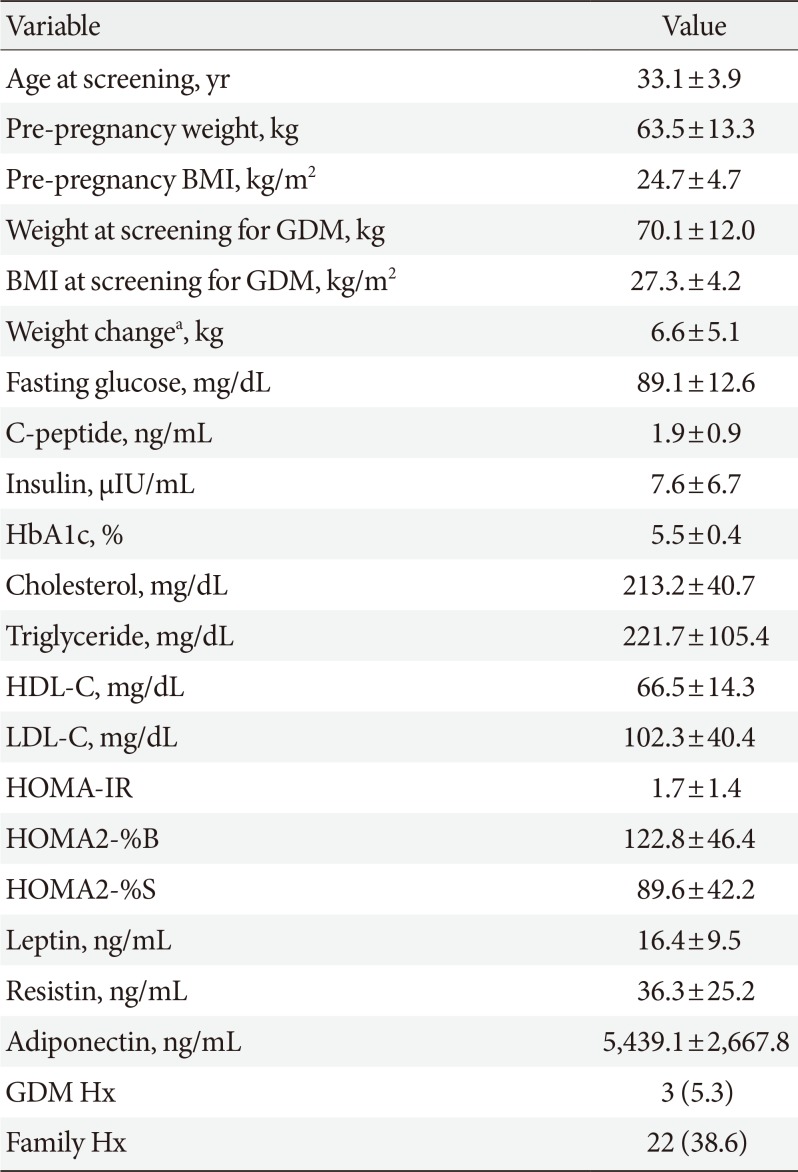

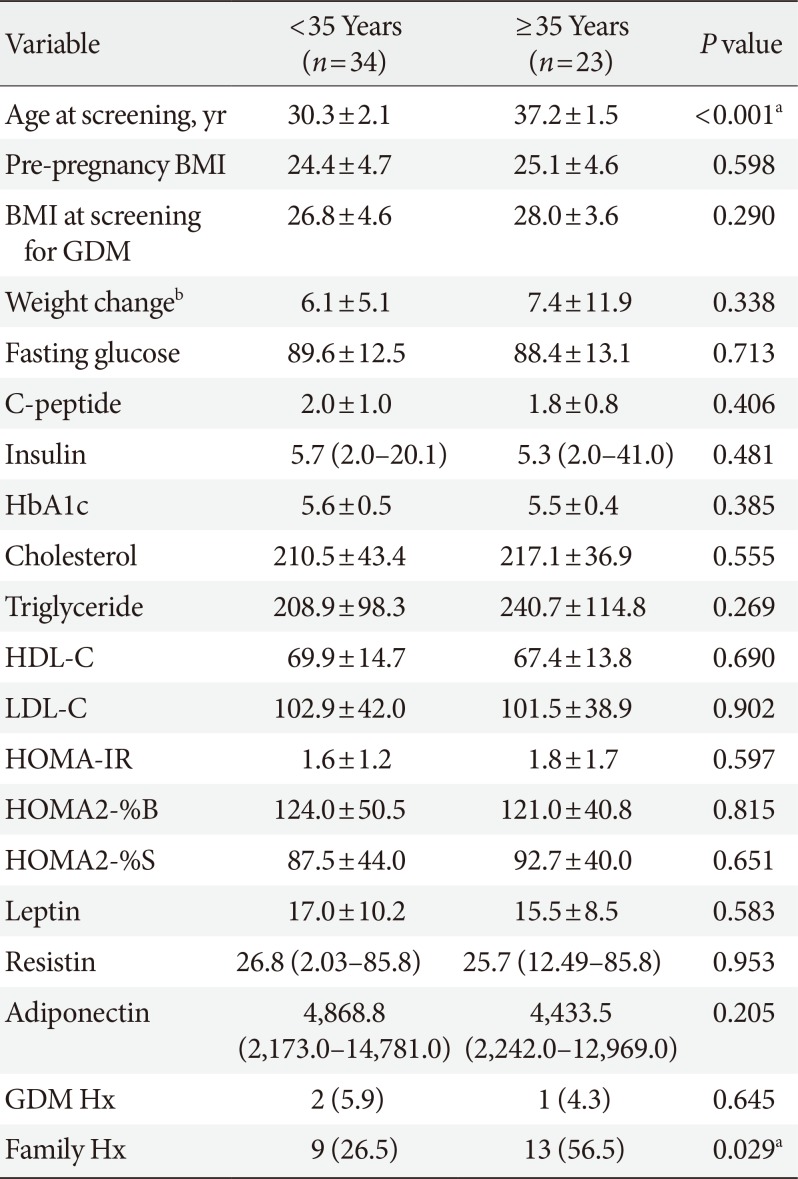
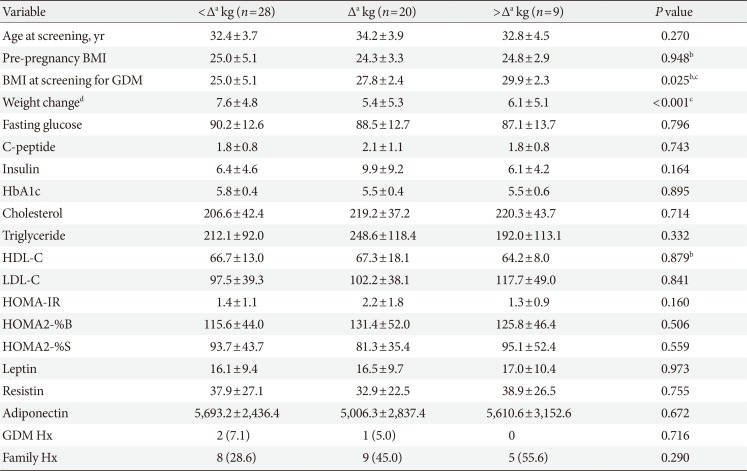
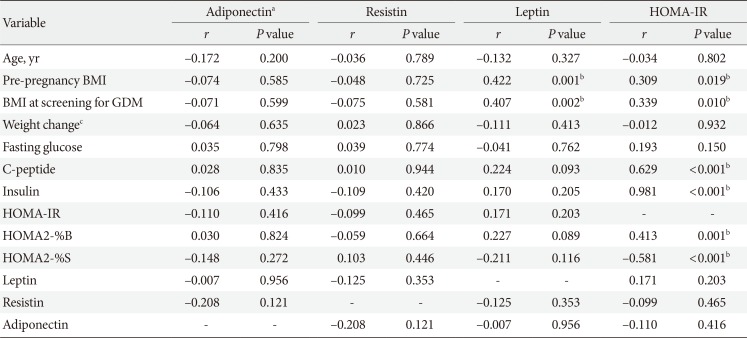
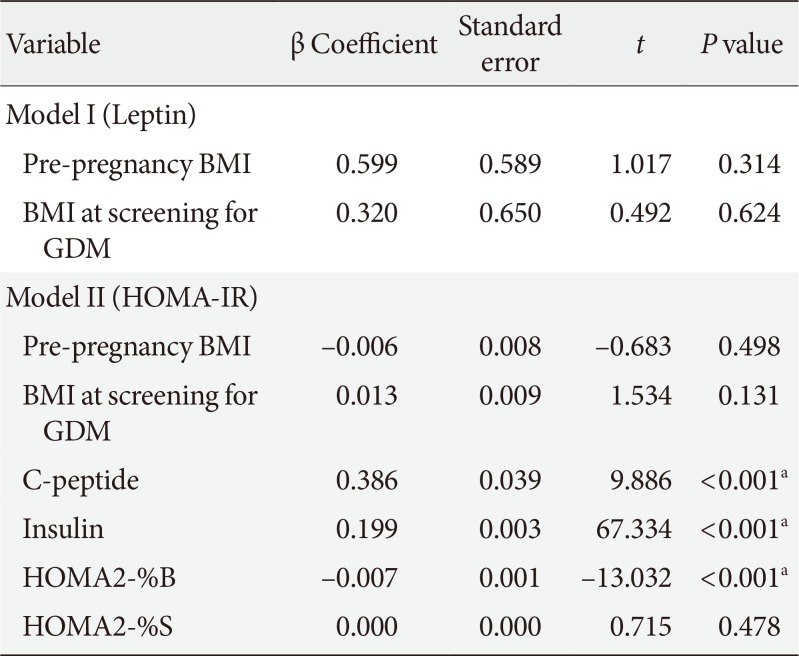




 PDF
PDF ePub
ePub Citation
Citation Print
Print



 XML Download
XML Download